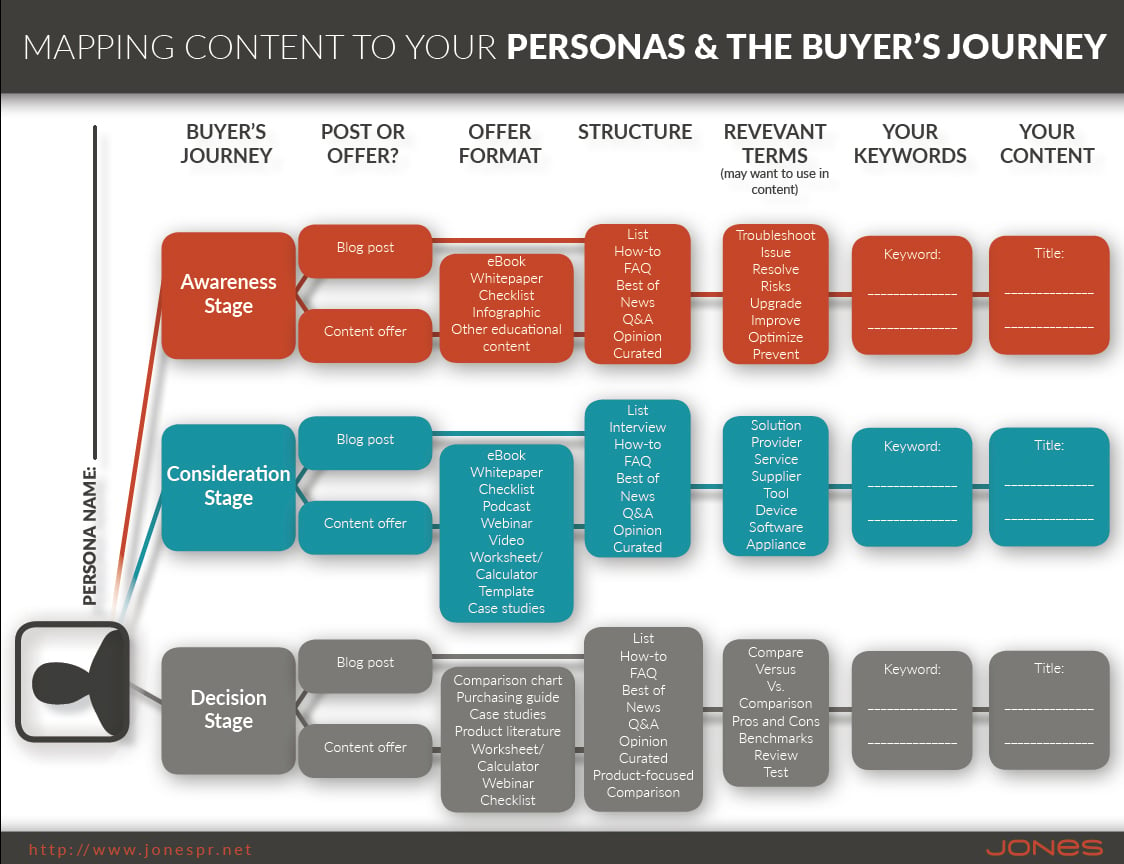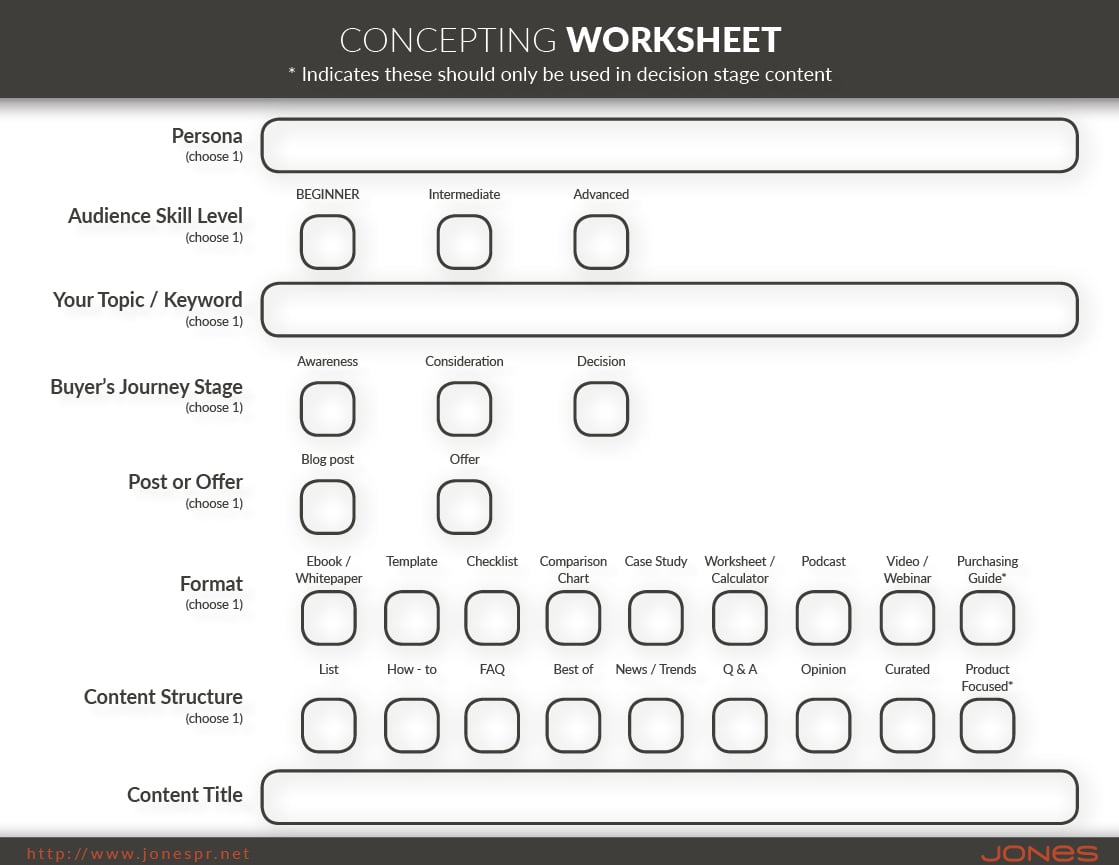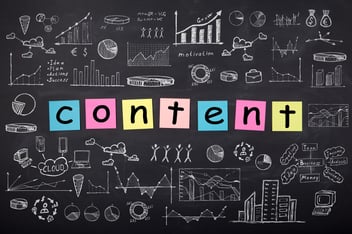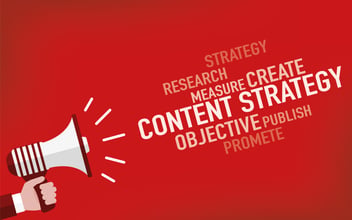How To Map Your Content To Match Buyer Personas (free template)
Each piece of content you create for your marketing strategy should have a specific audience in mind: a buyer persona (or multiple personas).
A buyer persona is a fictionalized, generalized representation of your ideal customers that help you understand your customers and potential customers better, and make it easier for you to tailor content to the specific needs, behaviors and concerns of different groups. You will likely have multiple personas that you target with slightly different information and benefit statements.
For example, a marketing software company may need to appeal to not only the user of the software—such as the CMO or individual marketing managers—but also the CFO involved in approving budget expenditures or even the head of sales who could have influence in decisions that impact shared data through CRM systems.
(Check this blog post for instructions on creating a great customer persona and the 10 characteristics it should include.)
Once you have your buyer personas in place, as you create each marketing campaign with a complete package of content, identify how you will tailor individual content pieces to reach each buyer persona.
We have developed a template that is perfect to use during strategy and planning sessions to decide on specific content types for each persona at each stage of the sales funnel, and then to pass on that essential information to the team member(s) responsible for creating the content.
Download Mapping Content To Your Personas & the Buyers Journey.

Begin by choosing a persona you want to reach with content from this specific campaign, then use the guides shown to narrow down a specific channel, approach, and content type, along with the keywords targeted for SEO purposes.
This template also helps you ensure that you create content considering the needs of your potential customers at each stage of the sales funnel or buyers’ journey.
Let’s walk through an example:
XYZ Company offers registration and bill collection software for healthcare facilities. They have identified two distinct buyer personas: the registrars who oversee the registration process and implement whatever solution is chosen and the CFOs who guide budget decisions regarding expenditures for software.
XYZ is centering their next campaign around the scalability of their solution to adapt to multiple locations. For registrars, one benefit of that scalability is that because the system works the same across all locations, they can reassign staff as needed to new locations without having to adjust training. For the CFO, the benefit is a cost-savings involved by being able to conduct training internally as the software is expanded to multiple locations, rather than hiring an outside firm, along with consistent reporting that makes tracking data more efficient.
Those differing benefits require different content to reach each persona, along with different tactics for each stage along the buyers’ journey. Ideally, each campaign you create will have at least one piece of content for each stage for each persona being targeted. For this example, we’ll only plot out one.
First—which persona will this piece of content be targeted to reach? Let’s say the CFO.
Second—which stage of the buyers’ journey will it target? Let’s say consideration. This assumes that the reader/prospect/lead is already at least somewhat familiar with our company and is actively considering new software solutions.
We want to offer useable information that answers questions and helps them see the benefits in our option without being overtly pushy about a sale, so we choose to create a content offer. We choose a webinar, first as a live interactive event, and then downloadable from our website as gated content. The idea behind the webinar will be to show how CFOs can use data from our solution to project revenues for the future and make budget decisions accordingly.
We identify the keyword phrases we want to incorporate into the web copy (for SEO), social media and emails that will accompany the webinar: revenue projections, budget analysis, and financial data management. And then we write a preliminary title.
With all of this information in hand, we can create an assignment to hand over to members of the marketing team who will determine who the webinar hosts will be, craft a script, design visuals to use in the webinar, and develop the plan for promoting it.

The second page of our Mapping Content To Personas worksheet is designed as an assignment template that can be filled out and passed along to the content creation team.
This can be supplemented with a detailed description of the target persona (see these examples if you are still creating your personas), as well as additional resources that are readily available for the person receiving the assignment to work from.
By taking time as you plan your campaigns and specific content to pinpoint which buyer persona and stage of the sales funnel each piece of content is designed for, you increase the effectiveness of your marketing content.
Download the content mapping worksheet shown here to use in your own planning process, or talk with me about how to develop and use buyer personas to target your own content marketing. You can schedule a consultation in my calendar for a quick no-obligation chat.
-1.png?width=1652&height=294&name=Jones(RGB)-1.png)









.jpg?width=352&name=Content%20Marketing_%20What%20Businesses%20Want%20To%20Do%20Better%20(infographic).jpg)


